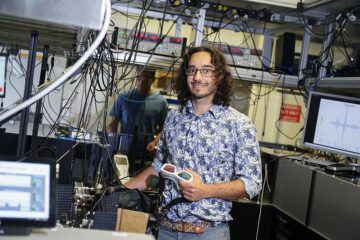Tropical Plants Help Identify Lags Between Abrupt Climate and Vegetation Shifts in Different Parts of the World

Clues to the timing and cause of abrupt climate changes in the past may lie in ocean floor sediments, according to a study by scientists at Woods Hole Oceanographic Institution (WHOI).
In a paper published May 21 in the journal Science through its Science Express web site, Konrad Hughen, Timothy Eglinton, Li Xu and Matthew Makou used multiple records of climatic and terrestrial vegetation change preserved in ocean floor sediments in the Cariaco Basin in Northern Venezuela. The sediment cores revealed rapid changes during the last deglaciation 15,000 to 10,000 years ago.
„Our data record rapid climate changes, as well as rapid vegetation changes,“ said Hughen, an associate scientist in the WHOI Marine Chemistry and Geochemistry Department and lead author of the report. While abrupt climate shifts occurred simultaneously in the high latitudes of the North Atlantic and in tropical South America, the WHOI researchers found that abrupt changes in tropical vegetation lagged the abrupt climate shifts by 25 to 50 years.
Previous studies of methane concentrations, a recorder of tropical wetland formation, in Greenland ice cores and temperature changes over Greenland were used to infer that tropical climate change may have lagged high-latitude changes, favoring a high-latitude trigger for abrupt shifts. In today’s study, however, the team’s findings provide evidence that tropical vegetation change lagged local tropical climate, and climate shifts at high and low latitudes were simultaneous. Thus the trigger for climate change may be in either or both the tropics or high-latitudes.
The reasons for a delayed response time for vegetation changes following abrupt climate shifts are unknown. „It takes a while for trees and plants to be impacted by climate shifts,“ Hughen said. „Some plants may be able to adapt for a longer period of time than others when faced with gradual rather than rapid climate changes.“
The study will be published later this year in Science magazine.
Woods Hole Oceanographic Institution (WHOI) is a private, independent marine research and engineering and higher education organization located in Falmouth, MA. Its primary mission is to understand the oceans and their interaction with the Earth as a whole, and to communicate a basic understanding of the ocean’s role in the changing global environment. Established in 1930 on a recommendation from the National Academy of Sciences, the Institution operates the US National Deep Submergence Facility that includes the deep-diving submersible ALVIN, a fleet of global ranging ships and smaller coastal vessels, and a variety of other tethered and autonomous underwater vehicles. WHOI is organized into five departments, interdisciplinary institutes and a marine policy center, and conducts a joint graduate education program with the Massachusetts Institute of Technology.
Media Contact
Weitere Informationen:
http://www.whoi.edu/media/2004_Konrad_Hughen.htmlAlle Nachrichten aus der Kategorie: Geowissenschaften
Die Geowissenschaften befassen sich grundlegend mit der Erde und spielen eine tragende Rolle für die Energieversorgung wie die allg. Rohstoffversorgung.
Zu den Geowissenschaften gesellen sich Fächer wie Geologie, Geographie, Geoinformatik, Paläontologie, Mineralogie, Petrographie, Kristallographie, Geophysik, Geodäsie, Glaziologie, Kartographie, Photogrammetrie, Meteorologie und Seismologie, Frühwarnsysteme, Erdbebenforschung und Polarforschung.
Neueste Beiträge

Neue universelle lichtbasierte Technik zur Kontrolle der Talpolarisation
Ein internationales Forscherteam berichtet in Nature über eine neue Methode, mit der zum ersten Mal die Talpolarisation in zentrosymmetrischen Bulk-Materialien auf eine nicht materialspezifische Weise erreicht wird. Diese „universelle Technik“…

Tumorzellen hebeln das Immunsystem früh aus
Neu entdeckter Mechanismus könnte Krebs-Immuntherapien deutlich verbessern. Tumore verhindern aktiv, dass sich Immunantworten durch sogenannte zytotoxische T-Zellen bilden, die den Krebs bekämpfen könnten. Wie das genau geschieht, beschreiben jetzt erstmals…

Immunzellen in den Startlöchern: „Allzeit bereit“ ist harte Arbeit
Wenn Krankheitserreger in den Körper eindringen, muss das Immunsystem sofort reagieren und eine Infektion verhindern oder eindämmen. Doch wie halten sich unsere Abwehrzellen bereit, wenn kein Angreifer in Sicht ist?…





















